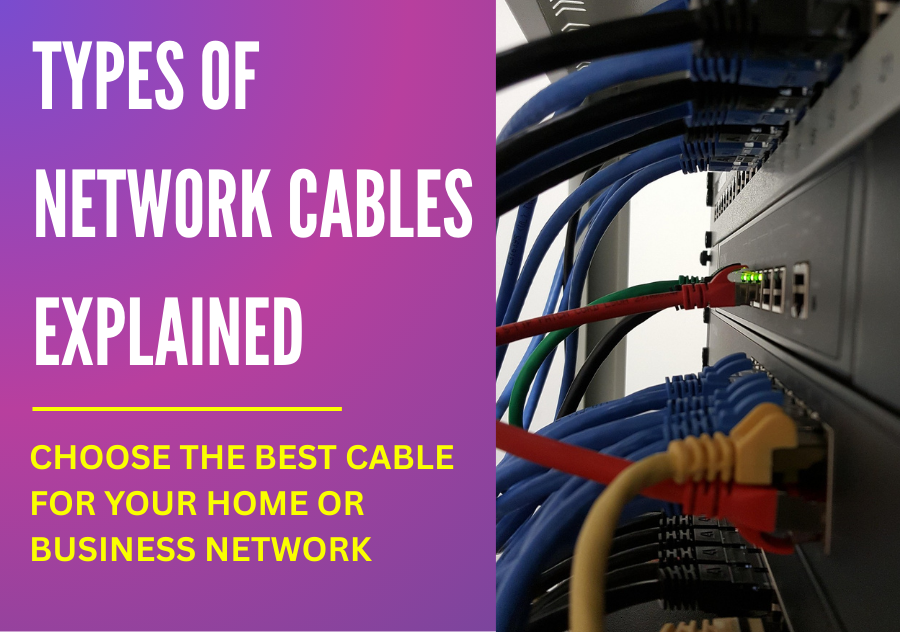Types of Network Cables Explained: Choose the Best Cable for Your Home or Business Network
Setting up a network may seem daunting, especially with the many types of cables available. However, understanding network cables is simpler than it appears.
This article explains the most common network cables in everyday language, helping you decide which cable suits your home or business network best. Moreover, it covers cable functions, categories, and use cases to give a clear picture.
What are Network Cables?
First of all, network cables are physical wires that connect devices like computers, routers, and switches. Their main job is to carry data signals so these devices can communicate smoothly. In a way, cables act as highways for digital information, directing traffic from one point to another.
Without proper cables, data transmission would be slow or unstable. Consequently, choosing the right cable is essential for network reliability and speed.
Twisted Pair Cables: Most Widely Used
Twisted pair cables are the most popular type for Ethernet networks. They contain pairs of insulated copper wires twisted together. This twisting reduces electromagnetic interference from external sources and from other wire pairs close by.
There are two main subtypes:
- Unshielded Twisted Pair (UTP): This is the standard cable found in most home and office networks. It balances cost and performance, supporting fast data speeds. Examples are Cat5e and Cat6 cables, widely used for gigabit Ethernet.
- Shielded Twisted Pair (STP): In environments with significant interference, STP cables include an additional shielding layer. This shielding further blocks noise, improving signal quality in challenging situations like factories or near heavy machinery.
Understanding Cable Categories and Performance
Twisted pair Ethernet cables come in different categories denoted by "Cat" plus a number. These categories define how fast and how far data can travel through the cable.
- Cat5e: Enhanced version of Cat5, supports speeds up to 1 Gbps over 100 meters. Ideal for most residential and small business needs.
- Cat6: Supports 10 Gbps speeds but over shorter distances (up to 55 meters). Designed for newer, faster networks.
- Cat6a and beyond: These support even higher speeds and improved noise resistance. They future-proof networks for growing data demands.
Choosing the right category depends on your network's speed requirements and distance between devices.
Coaxial Cables: Still Relevant in Some Areas
Coaxial cables consist of a single copper core surrounded by insulating material and a braided shield. Historically, these cables were widely used for cable TV and internet connections.
Even though modern Ethernet has largely replaced coaxial for LANs, coaxial cables remain common in broadband internet and television infrastructures. They are robust and offer good resistance to external interference.
Therefore, if you use cable internet or satellite services, coaxial cables likely connect your modem or set-top box.
Fiber Optic Cables: Leading Speed and Distance
Fiber optic cables carry data as pulses of light through tiny glass or plastic strands. Because light travels faster than electricity and doesn't degrade over long distances, fiber optic offers the fastest and most reliable data transmission available today.
Common fiber optic applications include:
- Internet service providers (ISPs) connecting neighborhoods.
- Data centers linking servers inside large facilities.
- Backbone networks connecting cities or regions.
Though fiber optics are more expensive and fragile compared to copper types, their advantages make them essential for high-speed, long-distance communication.
How Fiber Optic Cables Work
Fiber cables use total internal reflection to guide light signals down the tiny core. This method keeps the light inside the fiber with minimal loss, unlike copper cables which lose signal strength over distance.
Additionally, fiber cables are immune to electromagnetic interference, making them ideal in electrically noisy environments.
Fiber optic cables come in single-mode and multi-mode variants. Single-mode fiber supports very long distances with a tiny core and laser light, while multi-mode is used for shorter distances with LED light.

